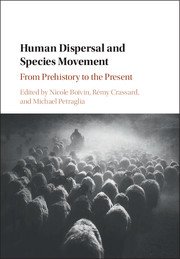Book contents
- Frontmatter
- Contents
- List of text boxes
- List of figures
- List of tables
- List of contributors
- Preface
- I Introduction
- II Origins: Species Movements in the Pleistocene
- III Across the water: Species movements by Coast and Sea
- 6 Coastlines, marine ecology, and maritime dispersals in human history
- 7 Breaking down barriers: Prehistoric species dispersals across Island Southeast Asia, New Guinea and Australia
- 8 The last great migration: Human colonization of the Remote Pacific Islands
- IV Complexity: Species Movements in the Holocene
- V Invasion: The Movement of Invasive and Disease Species
- Index
- Plate section
- References
7 - Breaking down barriers: Prehistoric species dispersals across Island Southeast Asia, New Guinea and Australia
from III - Across the water: Species movements by Coast and Sea
Published online by Cambridge University Press: 04 May 2017
- Frontmatter
- Contents
- List of text boxes
- List of figures
- List of tables
- List of contributors
- Preface
- I Introduction
- II Origins: Species Movements in the Pleistocene
- III Across the water: Species movements by Coast and Sea
- 6 Coastlines, marine ecology, and maritime dispersals in human history
- 7 Breaking down barriers: Prehistoric species dispersals across Island Southeast Asia, New Guinea and Australia
- 8 The last great migration: Human colonization of the Remote Pacific Islands
- IV Complexity: Species Movements in the Holocene
- V Invasion: The Movement of Invasive and Disease Species
- Index
- Plate section
- References
Summary
Abstract
The Holocene histories of Island Southeast Asia, New Guinea and Australia have often been portrayed in terms of clear regional distinctions. Each region had a distinctive character or signature: the maritime landscapes of Island Southeast Asia were widely inhabited by hunter-gatherer-fisher communities prior to colonisation by Austronesian language-speaking farmer-voyagers ultimately derived from Taiwan, the island of New Guinea was a place of early and independent agricultural development and plant domestication, whereas Australia was the continent of hunter-gatherers until settlement by Europeans within the last 250 years. A consideration of new multidisciplinary data challenges these regional (mis)conceptions, which are heavily based on isolationist and essentialist characterisations of long-term history. Human-aided dispersals of animal and plant species shed an increasing light on the socio-spatial inter-connections between the people who inhabited these regions.
Keywords: Species dispersal, Holocene, animal domesticates, plant domesticates, regionalism
The regional histories of Island Southeast Asia (ISEA), New Guinea and Australia are often characterised as exclusive, disconnected worlds prior to the late Holocene, and to a large degree until the last 500 years or so. In this chapter, such an isolationist view is challenged through an evaluation of the human-aided dispersals of animal and plant species within each region and between regions over the long-term. Although they may not have been as deeply enmeshed within a proto-globalised Old World as some other regions, either in terms of antiquity or degree, these three regions were still inter-connected. For example, this is clearly demonstrated by the dispersal of the dog/dingo (Canis familiaris), a Eurasian domesticate, to Australia by ca. 3,500 years ago.
In this chapter, the dispersals of animals and plants to and across ISEA, New Guinea and Australia are used to shed light on broader patterns of socio-spatial interconnection over the long-term. These dispersals show that these regions were not as isolated from each other, or the broader Old World, as is often portrayed. Certainly, there were distance-decay effects in terms of how species – as well as the knowledge of how to cultivate or husband them – dispersed, but these reflect geography rather than anything fundamentally different in the character of regional cultures or their histories.
- Type
- Chapter
- Information
- Human Dispersal and Species MovementFrom Prehistory to the Present, pp. 164 - 193Publisher: Cambridge University PressPrint publication year: 2017
References
- 5
- Cited by



